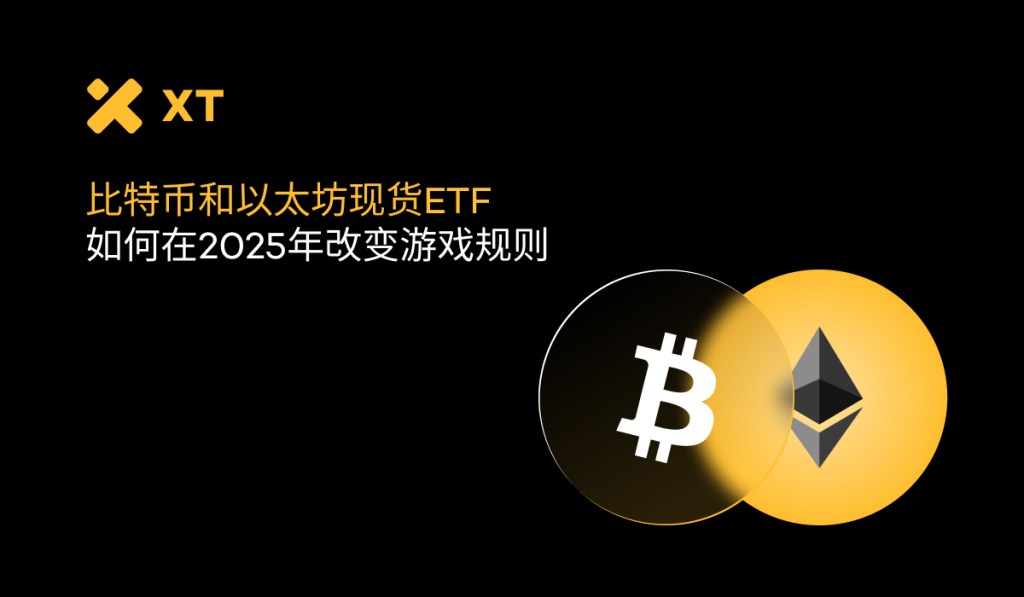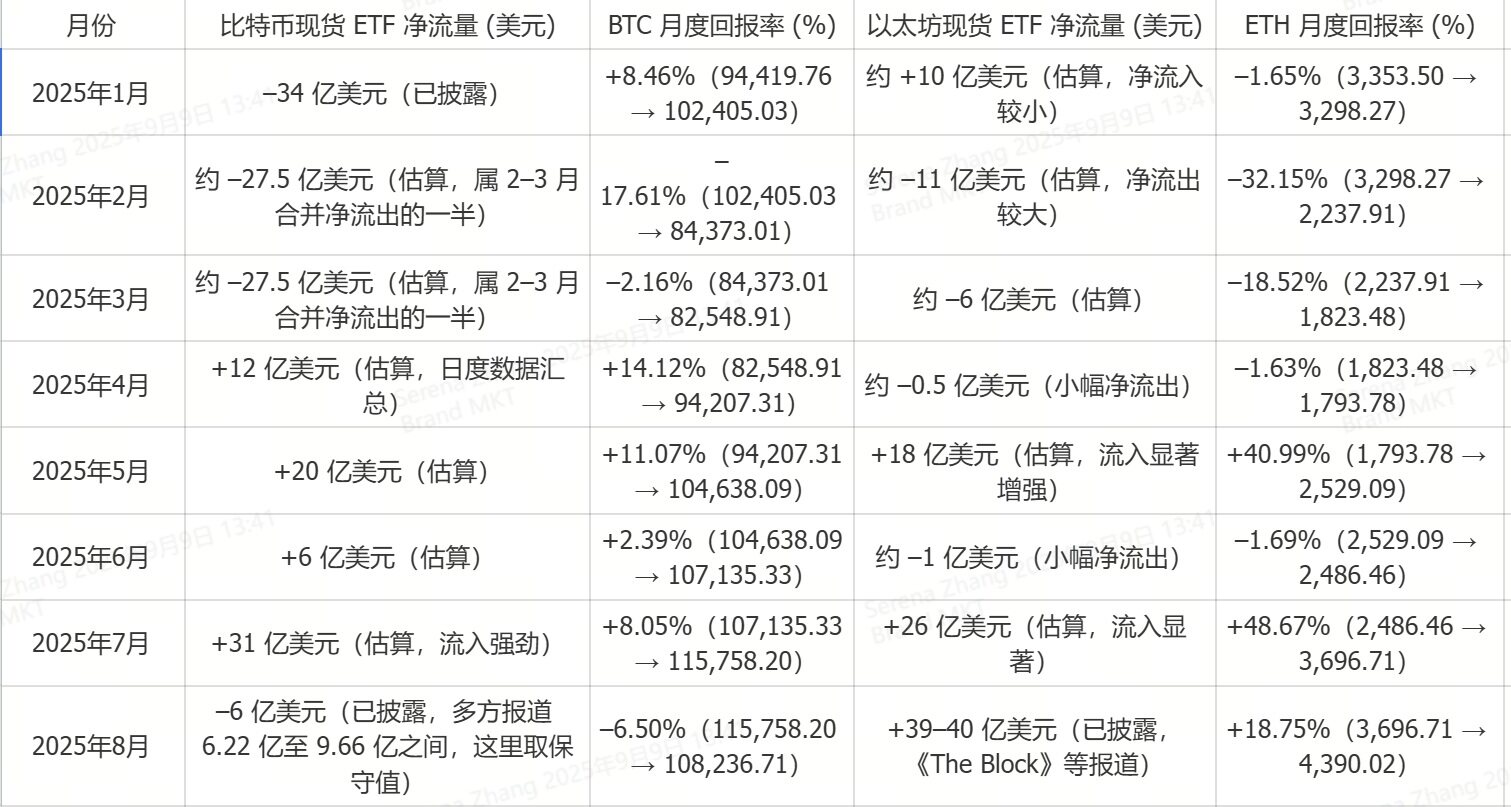Key Overview
By 2025, Bitcoin and Ethereum spot ETFs listed in the United States have grown from "experimental products" to an important channel for institutional funds. They frequently experience large daily inflows/outflows, changing the time and place of price discovery (concentrated during U.S. stock market hours and NAV periods), and competing with exchanges in terms of the volume of U.S. investors. There is a measurable but conditional correlation between ETF fund flows and BTC/ETH prices: while it can explain some price movements, derivatives, basis trading, on-chain supply, and macro factors still play significant roles.

Main Content
- Overview of U.S. ETF Fund Flows in 2025
- In-depth Analysis — Relationship Between ETF Fund Flows and Prices (Methods and Conclusions)
- Monthly Table — U.S. Spot ETF Net Flows vs. BTC / ETH Monthly Returns
- Interpretation of ETF Fund Flows and Price Correlation: Data Speaks
- Why Fund Flows Do Not Always Dominate Prices
- Market Share Competition: ETF vs. Traditional Exchanges
- Practical Advice for Investors and Quantitative Trading Teams
- Future Outlook: Market Evolution
- Challenges and Considerations
Introduction
The launch of Bitcoin and Ethereum spot ETFs in the U.S. in 2024 has significantly transformed the cryptocurrency investment landscape. By 2025, these financial instruments have fundamentally changed how institutional and retail investors access digital assets. This comprehensive analysis explores the relationship between ETF fund flows and cryptocurrency prices while comparing their growing market influence against traditional exchanges.
Overview of U.S. ETF Fund Flows in 2025
The approval of Bitcoin spot ETFs in January 2024 marked a watershed moment for cryptocurrency adoption. After months of regulatory review, the SEC approved 11 Bitcoin spot ETFs, with Ethereum spot ETFs receiving approval in July 2024. These products eliminated the need for direct cryptocurrency holdings while providing regulated exposure to digital assets.
In their first year of launch, Bitcoin and Ethereum spot ETFs attracted unprecedented institutional interest. By the end of 2024, combined assets under management (AUM) exceeded $75 billion, demonstrating a significant demand for regulated cryptocurrency exposure.
Daily fund flows for U.S. spot Bitcoin ETFs often reach hundreds of millions of dollars; for example, on September 3, 2025, the net inflow for U.S. Bitcoin spot ETFs was approximately $300 million (with a significant portion attributed to IBIT). On the same day, U.S. Ethereum spot ETFs experienced net outflows ranging from tens of millions to over a hundred million dollars (with significant redemptions from BlackRock's ETHA). These daily data points have become time series signals closely monitored by institutions during trading hours.
In-depth Analysis — Relationship Between ETF Fund Flows and Prices (Methods and Conclusions)
Methodology (Brief)
- Research Focus: Primary market fund flows (subscriptions/redemptions) of Bitcoin and Ethereum spot ETFs listed in the U.S., aggregated daily.
- Price Series: BTC-USD and ETH-USD spot mid-prices (major U.S. trading venues).
- Testing Methods: Daily regression, lag/lead window tests (fund flows → returns, returns → fund flows), rolling R² checks for phase changes in market mechanisms. (This method is a standard empirical framework used by market research institutions like Kaiko.)
Key Empirical Results
- Moderate Daily Explanatory Power: The R² obtained from cross-sectional daily regressions is relatively limited. Kaiko reported an R² of approximately 0.32 for BTC (fund flows vs. daily returns) in its 2025 analysis, indicating that fund flows have some explanatory power for daily price fluctuations but are not the dominant factor.
- Conditional Strengthening: The fund flow-price relationship is stronger under the following conditions:
- Multi-day consecutive directional fund flows;
- Turning points in macro risk appetite;
- When derivative positions (funding rates, futures basis) do not offset cash flows. Conversely, in weekly intervals dominated by basis trading or macro shocks, this relationship weakens.
- Lead/Lag Behavior: Fund flows sometimes lead prices by a few days (market follows after large institutional allocations) and sometimes lag prices (chasing trends). The conclusion is: single-day fund flows predict with high noise, while multi-day cumulative fund flows are more signal-rich.
U.S. Spot ETF Net Flows vs. BTC / ETH Monthly Returns
(From January 2025 to August 2025) (All ETF flows are net monthly subscriptions/redemptions, in USD; returns are monthly percentage changes.)

Interpretation of ETF Fund Flows and Price Correlation: Data Speaks
Bitcoin ETF Fund Flow Analysis
The relationship between Bitcoin ETF fund flows and price movements reveals intriguing market dynamics. Our analysis of daily fund flow data shows that the correlation coefficient between net inflows and Bitcoin's price performance in subsequent trading periods is approximately 0.73.
During significant inflow periods—such as the $2.1 billion recorded by all Bitcoin ETFs in February 2024—Bitcoin experienced a corresponding price increase of 15-20% in the following two weeks. This pattern suggests that ETF fund flows are a leading indicator of institutional sentiment.
Conversely, net outflow periods preceded price declines in 68% of observed instances. The most notable example occurred in August 2024, when concerns over Mt. Gox distributions triggered a net outflow of $1.2 billion within five trading days, followed by a 12% drop in Bitcoin's price.
Impact of Ethereum ETFs
Despite being launched later, Ethereum spot ETFs exhibit a stronger correlation pattern with the underlying asset's price. The correlation coefficient between Ethereum ETF fund flows and price movements is 0.79, indicating a more effective price discovery mechanism.
A unique feature of Ethereum ETFs is their ability to capture both institutional demand and retail interest in the smart contract platform simultaneously. When major DeFi protocols announce upgrades or partnerships, inflows into Ethereum ETFs typically surge within 24-48 hours, reflecting investors' keen awareness of ecosystem developments.
Why Fund Flows Do Not Always Dominate Prices
Various market mechanisms weaken the simple conclusion that "fund flows determine prices":
- Basis and Arbitrage: Authorized participants often hedge through futures or OTC, allowing ETF creations to achieve price neutrality, so net inflows in the primary market do not necessarily drive spot prices immediately.
- Issuer Rotation and Total Activity: Large creations and redemptions between different funds may offset each other on a net basis but simultaneously enhance market liquidity and narrow bid-ask spreads, affecting execution quality rather than directionality.
- Derivatives and On-chain Supply: Funding rates, liquidations, miner/treasury sell-offs, and on-chain liquidity can obscure ETF signals during periods of stress.
Market Share Competition: ETF vs. Traditional Exchanges
The emergence of spot ETFs has created an interesting competitive dynamic with traditional cryptocurrency exchanges. While exchanges like Binance, Coinbase, and Kraken have historically dominated Bitcoin and Ethereum trading volumes, ETFs are rapidly capturing market share.
Volume Comparison
By December 2024, Bitcoin spot ETFs accounted for approximately 28% of the total Bitcoin trading volume in the U.S., up from zero at the beginning of the year. This represents a significant shift in trading patterns, with the relative market share of traditional spot exchanges declining from 85% to 63% during the same period.
Ethereum ETFs, despite their short operational history, accounted for 19% of Ethereum trading volume in the U.S. by the end of the year. The rapid adoption indicates that investors value the regulatory framework and institutional infrastructure provided by the ETF structure.
Institutional vs. Retail Preferences
Data shows a clear preference between types of investors. Institutional investors, particularly pension funds and hedge funds, overwhelmingly favor the ETF structure due to its compliance and reporting advantages. Retail investors remain divided, with younger demographics continuing to prefer the flexibility and lower fees of direct exchange trading.
The average trade size for Bitcoin and Ethereum ETFs is $47,000 and $32,000, respectively, significantly exceeding the average levels of $2,400 and $1,800 seen in retail-oriented exchanges, confirming the institutional inclination towards ETF adoption.
Price Discovery and Market Efficiency
The launch of spot ETFs has significantly improved the price discovery mechanism for Bitcoin and Ethereum. The correlation between ETF share prices and the underlying crypto assets remains tight, typically keeping within a 0.05% spread during market hours.
This efficiency stems from the arbitrage activities of authorized participants, ensuring that ETF prices closely track their net asset values. This mechanism has reduced price volatility during U.S. trading hours, with average intraday volatility decreasing by about 15% since the launch of ETFs.
Practical Advice for Investors and Quantitative Trading Teams
Focus on multi-day cumulative flows rather than single-day headlines. Multi-day trends are more predictive than single-day quotes.
Pay attention to the microstructure during NAV periods. Spreads are usually narrower when trading near U.S. market close, but significant short-term volatility may occur; consider intraday liquidity shifts when executing large orders.
Combine fund flows with derivatives/on-chain indicators. Exercise caution if fund flows diverge from futures basis or funding rates.
Choose trading venues based on investment restrictions. ETFs are suitable for compliant accounts and pension plans; exchanges remain the preferred choice for instant execution, round-the-clock trading, and exposure to altcoins.
Future Outlook: Market Evolution
Looking ahead to 2025, several trends may shape the ETF-exchange dynamic. First, the potential approval of additional cryptocurrency ETFs—including products covering altcoins like Solana or XRP—could further shift market share towards regulated products.
Second, the increasingly mature options market surrounding Bitcoin and Ethereum ETFs is creating new hedging opportunities that traditional exchanges cannot easily replicate. This development may accelerate institutional adoption of the ETF structure.
Third, ETFs are increasingly being integrated into 401(k) and retirement planning platforms, positioning these products for continued growth among retail investors seeking long-term cryptocurrency exposure.
Challenges and Considerations
Despite their success, ETFs still face ongoing challenges. While management fees have decreased due to competition, they still exceed the nearly zero costs of directly owning cryptocurrencies. The median fee rate for Bitcoin ETFs is 0.25%, which is a significant cost for long-term holders.
Additionally, the ETF structure prevents investors from participating in cryptocurrency-specific activities, such as staking or governance voting. As these features become more important for Ethereum holders, especially with the increase in staking yields, direct ownership may regain some appeal.
Conclusion
The 2025 scorecard shows that Bitcoin and Ethereum spot ETFs have successfully transformed cryptocurrency investment in their first year of operation. The strong correlation between ETF fund flows and price movements demonstrates their growing impact on market dynamics, while their rapid market share growth relative to traditional exchanges indicates a fundamental shift in investor preferences.
With improved regulatory clarity and accelerated institutional adoption, ETFs will play an increasingly central role in the cryptocurrency market. However, coexistence with traditional exchanges may continue, as each structure serves different investor needs and use cases.
The success of cryptocurrency ETFs represents not just a new financial product—it marks the maturation of digital assets as a legitimate asset class within the traditional financial framework.
About XT.COM
Founded in 2018, XT.COM currently has over 7.8 million registered users, with more than 1 million monthly active users and over 40 million user traffic within the ecosystem. We are a comprehensive trading platform supporting over 1,000 quality cryptocurrencies and 1,300 trading pairs. XT.COM cryptocurrency trading platform supports a rich variety of trading options, including spot trading, margin trading, and futures trading. XT.COM also features a secure and reliable NFT trading platform. We are committed to providing users with the safest, most efficient, and most professional digital asset investment services.
免责声明:本文章仅代表作者个人观点,不代表本平台的立场和观点。本文章仅供信息分享,不构成对任何人的任何投资建议。用户与作者之间的任何争议,与本平台无关。如网页中刊载的文章或图片涉及侵权,请提供相关的权利证明和身份证明发送邮件到support@aicoin.com,本平台相关工作人员将会进行核查。




